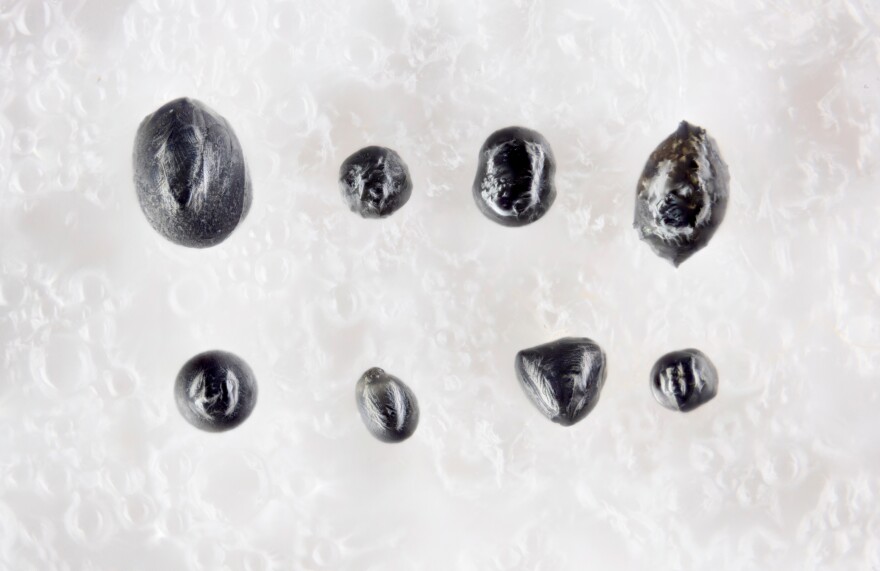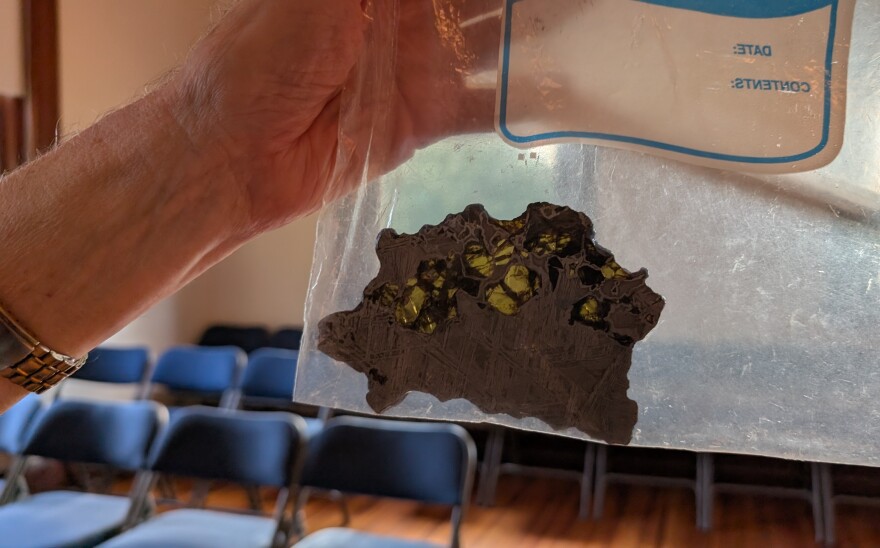Space is dirty. Filthy. It's littered with asteroids, and rocks, and dust. Some of that material falls to the Earth. When it enters the atmosphere, we call it a meteor. If it lands, it's a meteorite. Meteorite collectors gather in Cincinnati this weekend. They'll show off what they have and talk about how they got it.
Meteorites come in all shapes and sizes, but to collectors they’re all special.
John Ventre usually keeps his locked away in a safety deposit box, but he does bring them out occasionally.
He holds a silvery slice of jagged space rock against the light. It's about 6 by 4 inches, and an eighth of an inch deep.
"And what's neat about this particular one is… you can see pieces of olivene, which are translucent green gems."
Ventre, who's in his 90s, first started collecting when he was in college, and bought some meteorites at a museum gift shop.
He has donated some pieces, including a couple of 25 pounders, to the Cincinnati Observatory, but still has more than 100 in his collection
"The smallest one — gee, I don't know, would be about the size of a fingernail, I guess," he says.
Some collectors like Dusty Segretto of Louisville, Kentucky, have samples a lot smaller than that.
He set up a microscope inside a coffee shop and showed some to the store’s art curator, Beth Akins. His micrometeorite photographs were featured for the month of September.
Segretto had scooped up dirt and debris from the roof of the shop.
"Not much to look at from here, but this is eight micrometeorites. And you can look at them under the microscope too,” he says.
“Oh! They're beautiful!" says Akins.

Another slide is crowded with grains of sand, a couple of thread-like structures, and something that looks like a potato chip.
"And that's another thing about looking through the dirt, is you find so many other cool things."
Segretto says he spends about 16 hours a week searching.
"This is really a signal to noise game. Where you go up to a nice flat roof. Anything up there is either from wind or from space. You gather up some of the material and you separate it with a magnet."
He says that magnet will pull out anything with iron in it. And from there, it's like panning for gold.
"Imagine you had a clear bucket with clear water and sand in it and you swish it all around. The sand is going to fall real quickly to the bottom, right? It doesn't take very long,” he says. “But anything that's not heavy and dense is going to float. And so you keep pouring and pouring until that heavy stuff remains."
He looks through what's left. At a glance, it can be difficult to tell a meteorite from a normal earth rock. But, under that microscope, space dirt doesn't look like anything from Earth.
"They really stand out. They look different. They look beautiful. They have a structure to them. They have forms and colors that you don't see in terrestrial dirt because they went through a process via its entry to the earth that terrestrial material never really goes through."
Segretto says he loves looking for micrometeorites, because there's always the chance he'll find something no one has ever seen before.
"Even though they start from the same materials, they end up very different looking and have different personalities based on what happened to them on the planet. I feel like that's kind of like us. We all start from the same stuff but we have our own trajectories and it makes us unique. It makes us interesting and cool."
Segretto says you're never more than a meter away from a micrometeorite, and you'll never know what's there until you take the time to look for it.
More on the meet up
Cincinnati Observatory Astronomer Wes Ryle says several meteorite collectors, including Ventre and Segretto, will be on hand, showing off what they have.
“It comes from a desire to let kids and families get a chance to actually put their hands on something space-related,” he says. “As cool as it is to look at through a telescope at all these distant objects, the planets and the stars, it’s nice to have something tangible that you can hold on to that’s associated with space and the cosmos.”
Ryle says several collectors are expected.
“A lot of these meteorite collectors really enjoy having their specimens available for hands-on activities. They don’t really want them locked behind a case because they want folks to have that kind of experience,” he says.
Ryle says there also will be discussions and exhibits of "meteor-wrongs:" Rocks that look like they're from space but aren't. The Meet-a-Meteorite event is Saturday evening at the Cincinnati Observatory in Hyde Park.
Read more:







